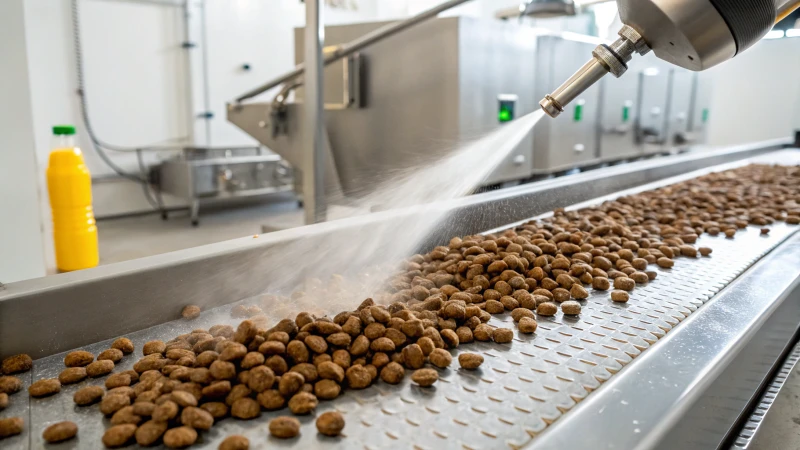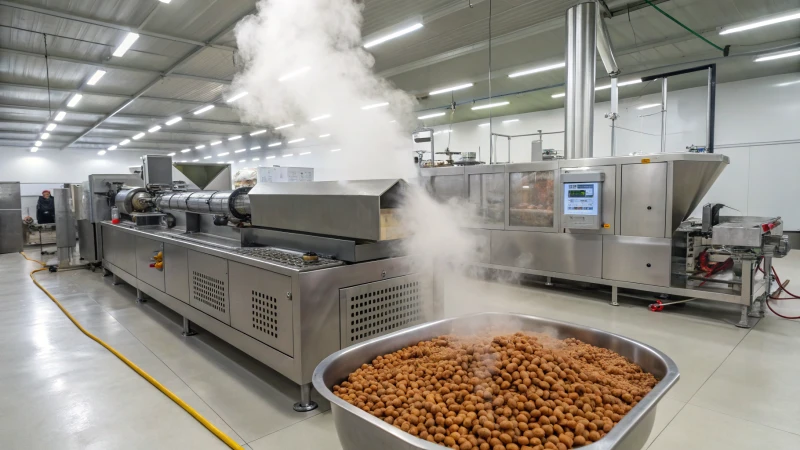
Food manufacturers face a common challenge: how to efficiently create uniform, shelf-stable, and nutritious food products at scale. Inconsistent texture, poor shelf life, or non-uniform shapes can make a product unmarketable. Enter food extrusion—a high-efficiency, continuous processing technique used worldwide for cereals, snacks, pet food, and meat substitutes. This technique solves multiple pain points simultaneously: it homogenizes ingredients, sterilizes them via heat and pressure, and forms them into specific shapes—all in one streamlined process. If you’ve ever eaten puffed cereal, textured vegetable protein, or cheese-flavored snacks, you’ve eaten extruded food. This article explains how the extrusion process works in the food industry with technical depth and practical clarity.
Food extrusion is a high-temperature, short-time (HTST) mechanical process in which moistened, starchy, and protein-rich raw ingredients are forced through a specially designed barrel under controlled conditions of temperature, pressure, and shear to produce a uniform, cooked, and shaped product. The output is then cut to length and cooled to achieve the final desired characteristics.
Understanding how food extrusion works requires a deeper look at both the mechanical systems involved and the thermodynamic transformations occurring inside the extruder. Whether you're a food scientist, product developer, or industrial buyer, this guide walks through every stage of the extrusion process and shows how it shapes modern food production.
Food extrusion is used to make pasta, snacks, and breakfast cereals.True
The food extrusion process is highly versatile and commonly used in the production of puffed snacks, ready-to-eat cereals, pasta, pet food, and textured vegetable protein.
🔍 Understanding the Food Extrusion Process
H2: What Is Food Extrusion?
Food extrusion is a thermo-mechanical process in which a pre-blended food mixture (usually composed of cereal grains, proteins, starches, and additives) is conveyed and cooked under controlled pressure and temperature through a specially engineered screw-barrel assembly. The cooked material is then forced through a die to shape it, followed by immediate cutting and cooling.
This process transforms raw food ingredients into structured, digestible, and appealing consumer products by applying controlled mechanical shear, heat, and moisture.
Stages of the Food Extrusion Process
| Step | Description |
|---|---|
| Ingredient Preparation | Raw materials like cornmeal, soy flour, wheat flour, and additives are pre-blended for uniformity and moisture adjustment (typically 15-25%). |
| Feeding | The mix is continuously fed into the extruder hopper via volumetric or gravimetric feeders. |
| Preconditioning | Optional step involving pre-moistening and pre-heating using steam and water to begin the cooking process and reduce energy consumption. |
| Extrusion Cooking | Inside the barrel, one or more screws convey the material forward while pressure, friction, and heat cook the product. |
| Die Shaping | The hot, pressurized mass is forced through a custom die at the extruder outlet to determine the shape (stars, rings, tubes, flakes, etc.). |
| Cutting | Rotary knives at the die face cut the extrudate into uniform sizes while it exits under pressure. |
| Drying or Cooling | Extruded pieces are cooled and/or dried to achieve target moisture content and shelf stability. |
| Seasoning and Packing | Final products may be seasoned, coated, and packaged for distribution. |
Types of Extruders Used in Food Production
| Extruder Type | Characteristics | Applications |
|---|---|---|
| Single-Screw Extruder | Simple design, lower cost, ideal for less complex formulations. | Pasta, dry pet food, puffed snacks |
| Twin-Screw Extruder | Higher flexibility, better mixing, handles high-moisture or viscous materials. | Textured vegetable protein, baby food, meat analogs |
Thermal & Mechanical Behavior Inside an Extruder
The extruder works as both a reactor and a molding device. Here's what happens inside:
- Shear & Compression: The screws rotate, pushing material through compression zones.
- Friction & Heat: Mechanical energy transforms into heat, cooking the ingredients.
- Expansion: At the die exit, the sudden pressure drop causes the product to expand (puff), forming porous structures.
Key Variables That Influence Extrusion Quality
| Variable | Impact on Product |
|---|---|
| Barrel Temperature | Controls starch gelatinization and protein denaturation. |
| Screw Speed | Influences residence time, mixing, and shear. |
| Die Design | Determines final shape and texture. |
| Moisture Content | Affects viscosity, expansion, and final crunch or chewiness. |
| Ingredient Ratio | Different blends change binding, mouthfeel, and nutritional profile. |
Applications of Extruded Foods
| Product Category | Examples |
|---|---|
| Breakfast Cereals | Cornflakes, puffed rice, multi-grain rings |
| Snacks | Cheese puffs, extruded chips, tortilla snacks |
| Meat Substitutes | Textured vegetable protein, soy curls |
| Pet Food | Dry kibble for dogs and cats |
| Pasta & Noodles | Macaroni, instant noodles |
📊 Chart: Effect of Moisture Content on Extrudate Texture
| Moisture Content (%) | Product Texture |
|----------------------|---------------------|
| 12–16% | Hard and crunchy |
| 17–20% | Slightly crispy |
| 21–25% | Soft and chewy |🧪 Technical Focus: Nutrient Retention in Extrusion
Extrusion is often criticized for nutrient loss due to heat. However, the short-time, high-temperature design actually helps preserve certain heat-sensitive vitamins better than boiling or baking. Moreover, nutrient premixes can be added post-extrusion via oil coating.
Key facts:
- Vitamin Retention: Thiamine and riboflavin have \~70–90% retention.
- Amino Acids: Essential amino acids such as lysine remain stable under controlled conditions.
- Enzyme Inactivation: Anti-nutritional factors like trypsin inhibitors in soy are deactivated.
🧠 Case Study: High-Protein Meat Analogs via Twin-Screw Extrusion
In a commercial-scale operation, soy protein concentrate blended with wheat gluten and water (35% moisture) is extruded at 140°C using a twin-screw extruder. The extrudate mimics the fibrous texture of meat. Post-processing includes slicing, marinating, and packaging. Result: A meat-free protein product with 65% protein content and excellent chewability.
📚 Additional Applications and Innovations
- Fortified Foods: Used to deliver vitamins, minerals, and dietary fiber.
- 3D Extrusion: Emerging tech allows for layered snacks and intricate shapes.
- Low-Glycemic Snacks: Novel formulations with legumes and fibers support diabetic-friendly products.
Summary
Food extrusion is one of the most transformative innovations in modern food manufacturing. It combines multiple unit operations—mixing, cooking, forming, and sterilizing—into a continuous, controllable, and scalable process. Whether creating cereal puffs or sustainable meat alternatives, extrusion allows manufacturers to deliver consistent, nutrient-rich, and shelf-stable products.
📞 Ready to Innovate with Food Extrusion?
If you’re looking to develop custom extruded food products or need industrial-grade extruders, contact us today. We provide full turnkey solutions from R\&D to production line installation. Let's shape the future of food—together.

FAQ
Q1: What are the main steps in the food extrusion process?
A1: The food extrusion process consists of several key steps:
- Mixing – Raw ingredients like grains, proteins, and additives are blended into a uniform mixture.
- Feeding – The mix is fed into the extruder via a hopper.
- Cooking & Pressurizing – Inside the extruder barrel, screws rotate to cook and pressurize the mix using high heat and shear force.
- Shaping – The hot mixture is forced through a die to form specific shapes.
- Cutting – A rotating knife cuts the extruded product to the desired size.
- Drying & Cooling – Moisture is reduced in a dryer and the product is cooled for packaging.
Q2: What types of food can be made through extrusion?
A2: A wide variety of foods can be produced via extrusion, including:
- Breakfast cereals
- Snack foods (e.g., puffs, chips)
- Pasta and noodles
- Pet food and aquafeed
- Textured vegetable proteins (TVP)
- Nutritional bars and supplements
Q3: Why is extrusion used in food processing?
A3: Extrusion offers numerous advantages, such as:
- Uniform product quality
- Efficient large-scale production
- Versatility in shape and texture
- Improved digestibility
- Pathogen elimination through high temperatures
- Long shelf life
Q4: What’s the difference between single-screw and twin-screw extrusion?
A4: Single-screw extruders are simpler and suitable for straightforward recipes. Twin-screw extruders offer better mixing, flexibility, and are ideal for complex or multi-phase ingredients, higher fat levels, and continuous production needs.
Q5: How does extrusion impact food nutrition?
A5: While high temperatures may degrade some sensitive vitamins, extrusion enhances starch gelatinization, protein digestibility, and reduces antinutritional factors. Nutrients lost during extrusion can be reintroduced via post-extrusion coating or spraying.
References
- ScienceDirect – Food Extrusion Overview: https://www.sciencedirect.com/topics/food-science/extrusion
- Wiley Online Library – Food Extrusion Principles: https://onlinelibrary.wiley.com
- Pet Food Processing – Manufacturing Insights: https://www.petfoodprocessing.net
- Alltech – Benefits of Extrusion: https://www.alltech.com
- Feed Strategy – Pet and Aquafeed Production: https://www.feedstrategy.com
- American Society of Agricultural and Biological Engineers – https://www.asabe.org
- Food Engineering Magazine – https://www.foodengineeringmag.com









